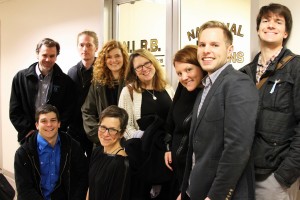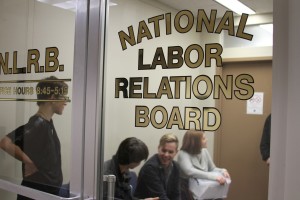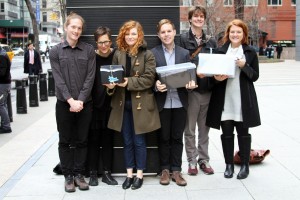FILINGS | UPDATES | FAQS
NLRB Decision Granting Collective Bargaining Rights [8/23/2016]
Filings on Eligibility Issues [10/12/2016]
Direction of Election [10/31/2016]
Supplemental Decison on Objections and Notice of Hearing [1/4/2017]
Briefs on objections – Union | Employer [2/1/2017]
Regional NLRB’s Objections Report and Recommendations [3/6/2017]
Exceptions filed by the University, Briefs in Support of Exceptions | GWC Response [3/17/2017]
Certification of Our Union [December 16, 2017]
BRIEFS ON REVIEW + AMICUS BRIEFS
GWC-UAW Brief on Review | Columbia Brief on Review
GWC-UAW Reply to Columbia’s Brief [Appendix] | Columbia’s Reply to GWC-UAW’s Brief
AFL-CIO | American Federation of Teachers | American Association of University Professors | Attorney Ellen Darin | Labor-Social Science Professors | National Association of Graduate-Professional Students | NLRB General Counsel | Service Employees International Union and Committee of Interns and Residents | United Steel Workers
American Council on Education, et. al. | Harvard, Yale, UPenn, Princeton, et. al. | Higher Ed Council of the Employment Law Alliance | National Right to Work
- Notice and Invitation to File Briefs 1/13/2016
- Order Granting Request for Review 12/23/2015
- Columbia University’s Response to Request for Review 11/20/2015 | Petitioner’s Opposition to Employer’s Conditional Request for Review 11/20/2015
- Petitioner’s Request for Review 11/13/2015 | Columbia University’s Conditional Request for Review 11/13/2015
- Regional Board Director’s Decision 10/30/2015
- Petitioner’s Brief to the Regional Director 6/24/2015 | Columbia University’s Brief to the Regional Director 6/24/2015
- NLRB Order Granting Request for Review 3/13/2015
- Petitioner’s Request for Review 2/20/2015 | Columbia University’s Reply to Petitioner’s Request for Review 2/27/2015
- NLRB Region Order Dismissing Petition 2/6/2015
- Petitioner’s Response to Order to Show Cause 1/20/2015 | Columbia University’s Response 1/27/2015
HEARING TRANSCRIPTS
March 31, 2015 | April 2, 2015 | April 9, 2015 | April 22, 2015
April 24, 2015 | April 27, 2015 | April 28, 2015 | May 12, 2015
May 13, 2015 |May 21, 2015 | May 27, 2015
- What is the NLRB?
- What is the NLRB process?
- What is the Brown decision and how does it impact the NLRB process for graduate workers at private universities?
- Where is GWC in the NLRB process?
- What’s the difference between a student and a worker?
- What is the Columbia Administration’s current stance?
- Are GWC-UAW’s NLRB filings available online?
UPDATED August 16, 2016
- What is the NLRB decision?
- When do we expect the NLRB decision?
- If the NLRB overturns the Brown decision, will Columbia have to recognize the Union?
- If the NLRB holds an election, who can vote?
- When would the vote take place?
- How does the vote work?
- How many people have to vote yes for us to establish GWC-UAW as our Union?
- If GWC-UAW wins the election, what happens next?
The NLRB, or National Labor Relations Board, is a federal agency that was established to safeguard workers’ rights as defined in the National Labor Relations Act of 1935, which lays out the right to collective bargaining and related matters.
The typical NLRB process begins when employees submit a petition seeking to be represented by a union. The petition is then evaluated by the NLRB’s Regional Director, who conducts an investigation and holds hearings — if there are disputes between the union and employer — in order to determine which employees can be part of the union’s “bargaining unit,” or the group that will be covered in a union contract. Once the bargaining unit has been determined, the Regional Director will then conduct a representation election, in which all members of the bargaining unit can vote yes or no on forming a union. If a majority of voters votes yes, then the union is certified and empowered to elect a bargaining committee, democratically determine bargaining priorities, and sit down with the employer to negotiate a contract, which must then be ratified by a majority vote of those eligible.
What is the Brown decision and how does it impact the NLRB process for graduate workers at private universities?
Graduate workers at private universities have to travel a slightly more complicated route through the NLRB because of a partisan 3-2 decision reached in 2004 in the case of Brown University. In Brown, the Bush-appointed majority found that graduate workers at private universities are primarily students and thus do not have the right to collective bargaining. Because of this decision, graduate workers at private schools must either seek voluntary recognition by their universities (as happened at NYU in 2013), or have the NLRB overturn the 2004 Brown precedent and restore collective bargaining rights for RAs and TAs. Given the Board’s current pro-employee majority, which has demonstrated a commitment to furthering the right of employees to engage in collective bargaining, and their repeated indications that they wish to reconsider the Brown decision, we believe there has never been a better time for graduate workers at private universities to petition the NLRB to overturn Brown.
In contrast to private universities, graduate workers at public universities are covered by state labor laws, many of which recognize collective bargaining rights. Indeed, there are established labor unions for graduate workers at more than 60 public universities nationwide.
Where is GWC in the NLRB process?
GWC-UAW approached the Columbia Administration in December 2014 with the hope of negotiating a process for voluntary recognition. When the administration failed to respond, we submitted a petition to the NLRB Regional Director for New York. In early February, the Regional Director, at the request of the University, dismissed our petition based on the precedent set by the 2004 Brown decision. GWC-UAW then appealed to the NLRB in Washington, DC, urging the Board to reinstate the petition and conduct a hearing in order to build a body of facts on which to reevaluate Brown. The National Board agreed with GWC-UAW, and on March 13 ordered the New York Regional Director to hold hearings on our case. These hearings began on March 31 and ended in June.
In October 2015 the NLRB Regional Director dismissed our petition citing that she was constrained by the Brown decision, but found that research and teaching assistants for all purposes were workers. We subsequently filed a motion to request review by the NLRB in Washington, DC.
What’s the difference between a student and a worker?
GWC-UAW believes that there is no incompatibility between being a student and a worker. When RAs and TAs work in labs and teach seminars and discussion sections, we perform the revenue-generating labor that makes Columbia a world-class institution. We believe this labor clearly makes us employees under the terms of the National Labor Relations Act, and thus gives us the right to bargain collectively over the conditions under which we perform this work. This is also true of apprentices, who learn while working but have the right to unionize under the terms of the NLRA.
What is the Columbia Administration’s current stance?
The Columbia Administration has refused to recognize our democratic majority. Instead, they have hired an expensive, private law firm that specializes in helping employers stop unionization campaigns, Proskauer Rose, to fight us at the NLRB and slow the process down as much as possible. Proskauer Rose’s NLRB filings have rehearsed stale arguments suggesting that we cannot be workers because we are also students. President Bollinger has also made comments to this effect, claiming that collective bargaining for academic workers would somehow be detrimental to the “scholarly temperament.” Left unspecified is why being both a student and a worker is somehow incompatible, or how collective bargaining will prejudice our work as scholars — likely because there is no evidence that it will.
Are GWC-UAW’s NLRB filings available online?
Documents pertaining to our NLRB case can be found here.
What is the NLRB decision?
Based on petitions for union representation filed by a majority of research and teaching assistants (RAs and TAs) at Columbia University (GWC-UAW) and at The New School (SENS-UAW), the National Labor Relations Board (NLRB) is likely to decide soon whether or not to restore the right to collective bargaining for RAs and TAs at private universities. The NLRB affirmed this right in 2000, in a case at New York University, after which RAs and TAs there voted to unionize and negotiated major improvements – including a 38 percent increase to minimum stipends and paid health insurance for the first time – in the first-ever union contract for RAs and TAs at a private university. George W. Bush appointees to the NLRB took away this right in a 2004 ruling regarding a similar petition at Brown University, saying that RAs and TAs were primarily students and that, therefore, private universities had no obligation to bargain with unions of RAs and TAs.
When do we expect the NLRB decision?
While we cannot guarantee an exact time when the NLRB will make a decision on the petitions at Columbia and the New School, many observers believe they will decide before the end of summer 2016.
If the NLRB overturns the Brown decision, will Columbia have to recognize the Union?
If the NLRB overturns Brown, the ruling itself will not require Columbia to recognize and bargain with the Union. It would trigger a process where the NLRB would schedule an election in which RAs and TAs would vote on having GWC-UAW be our Union. If a majority votes “yes,” then the NLRB would certify GWC-UAW as our Union, and Columbia would be legally obligated to bargain in good faith with our elected bargaining committee for a contract.
If the NLRB holds an election, who can vote?
If the NLRB overturns the Brown decision, part of the decision would be determining the “bargaining unit,” the group of workers who are eligible to unionize. Those included in that defined unit would be eligible to vote. At both Columbia and The New School, based on majority support from all parts of campus, the Union has petitioned to represent all RAs and TAs.
When would the vote take place?
Details such as time, place and who is eligible to vote are worked out between the union, the university, and the NLRB. If the decision comes before the end of the summer, we would expect to have the election in the Fall semester.
How does the vote work?
The election is administered by the NLRB. Typically, the vote would be held onsite at the university and all eligible voters would be notified in advance of the times and locations. The ballot would ask voters to indicate “yes” to representation by GWC-UAW or “no union.” The vote is by secret ballot.
How many people have to vote yes for us to establish GWC-UAW as our Union?
It takes a simple majority of those voting to establish GWC-UAW as our Union, but if we want to build momentum to win a strong contract, it will be important to have support from a majority of all eligible RAs and TAs.
If GWC-UAW wins the election, what happens next?
After a successful election, we would do the following to prepare for and engage in the process of negotiating a contract with Columbia: nominate and elect a bargaining committee from among RAs and TAs; based on existing and further surveys, the committee would develop initial bargaining goals; the committee would ask for RAs and TAs to vote on those goals; the committee would work to schedule dates with the University to start contract negotiations; when the committee has negotiated a tentative agreement with the University they feel they can recommend, RAs and TAs would vote whether to ratify it as the first contract; after the contract is ratified, the membership would elect representatives who help run the Union and help members with any problems they have in the workplace.





